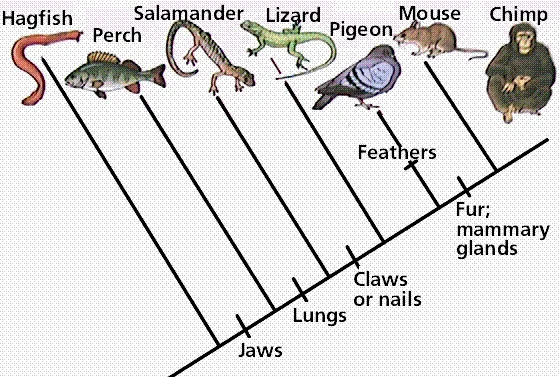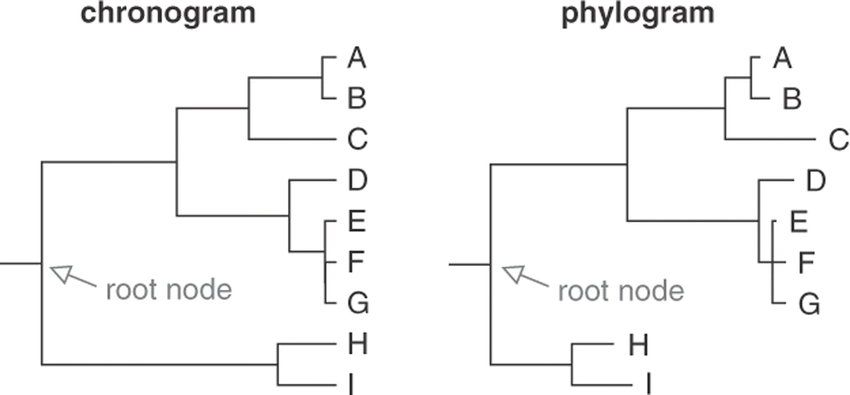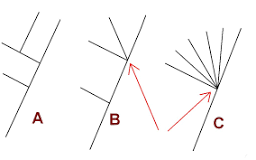Academic Bowl Biology Vocabulary
5.0(1)
Card Sorting
1/54
Study Analytics
Name | Mastery | Learn | Test | Matching | Spaced |
|---|
No study sessions yet.
55 Terms
1
New cards
Analogous
Performing a similar function but having a different origin, such as the wings of insects and birds.
2
New cards
Apomorphy
A specialized trait that is unique to a group or species. A character state (such as the presence of feathers) not present in it’s ancestral form.
3
New cards
Binomial
Binomial nomenclature. The formal system of naming species of living things by giving each a name composed of two parts, both of which use Latin grammatical forms.
4
New cards
Biodiversity
A term *that describes every living organism within a single ecosystem or habitat*, including numbers and diversity of species.
5
New cards
Branch (Phylogenetic Trees)
A branch on a phylogenetic tree represents a lineage between two splitting events.
6
New cards
Clade
A clade is a piece of a phylogeny that includes an ancestral lineage and all the descendants of that ancestor. This group of organisms has the property of monophyly (from the Greek for "single clan"), so it may also be referred to as a monophyletic group.
7
New cards
Cladistics
A method of classification of animals and plants according to the proportion of measurable characteristics that they have in common. It is assumed that the higher the proportion of characteristics that two organisms share, the more recently they diverged from a common ancestor.
8
New cards
Cladogram
A branching diagram showing the cladistic relationship between a number of species.

9
New cards
Classification
The establishment of a hierarchical system of categories on the basis or presumed natural relationships among organisms. Commonly called taxonomy.
10
New cards
Convergence
When two or more things come together to form a new whole. Comes from the prefix con-, meaning together and verge, meaning to turn toward.
11
New cards
Convergence (Evolutionary Terms)
The process whereby distantly related organisms independently evolve similar traits to adapt to similar necessities.
12
New cards
Divergence (Evolutionary Terms)
The evolution of dissimilar traits or features (as in body functions and behavior) in closely related populations, species, or lineages of common ancestry that typically occupy dissimilar environments or ecological niches.
13
New cards
Evolution
Change in the heritable characteristics of biological populations over successive generations. These characteristics are the expressions or genes, which are passed on from parent to offspring during reproduction.
14
New cards
Gene
The basic unit of heredity passed from parent to child. Genes are made up of sequences of DNA and are arranged, one after another, at specific locations on chromosomes in the nucleus of cells.
15
New cards
Genetic
Relating to genes or heredity; Relating to origin, or arising from a common origin.
16
New cards
Genotype
The genetic makeup of an organism, or an organism’s complete set of genes.
17
New cards
Hereditary
The passing of genetic information from parent to child through the genes in sperm & egg cells.
18
New cards
Homologous
Two anatomical structures or behavioral traits within different organisms which originated from a structure or trait of their common ancestral organism.
19
New cards
Homology
A similarity due to common origin at all levels (organism, population species.)
20
New cards
Homoplasy
Similarity due to common origin at the organism and population levels, but without common origin at the species level.
21
New cards
Ingroup
A group of living organisms whose relationships are being considered in a cladogram. Thus it is comprised of the vast majority of the branches in a cladogram.
22
New cards
Internode (Phylogenetic Trees)
A line connecting two speciation events and represents at least one ancestral species.
23
New cards
Monophyletic group
A monophyletic group, also called a clade, includes an ancestral taxon and all of it’s descendants.
24
New cards
Morphology/Morphological
A broad term meaning the science of the form and structure of organisms.
25
New cards
Node (Phylogenetic Trees)
A branching point from the ancestral population.

26
New cards
Nomenclature
A system of naming organisms in biology and beyond. The species to which the organism belongs is indicated by 2 words, the genus and species name.
27
New cards
Outgroup
A more distantly related group of organisms that serves as a reference group when determining the evolutionary relationships of the ingroup, the set, or the organisms under study.
28
New cards
Paraphyletic group
A group that consists of the last common ancestor and most of it’s descendants, excluding a few monophyletic subgroups.
29
New cards
Parsimony
A principle that tells us to choose the simplest scientific explanation that fits the evidence.
30
New cards
Phenotype
The observable characteristics in an individual resulting from the expression of genes; the clinical presentation of an individual with a particular genotype.
31
New cards
Phylogenetic Tree
Also known as a phylogeny, is a diagram that depicts the lines of evolutionary descent of different species, organisms, or genes from a common ancestor.
32
New cards
Phylogenetic/Phylogenetics
The systematic study of reconstructing the past evolutionary history of extant species or taxa, based on present-day data, such as morphologies or molecular information.
33
New cards
Phylogeny
The branch of biology that deals with phylogenesis. Can also be a term for a phylogenetic tree.
34
New cards
Phylogram
A scaled phylogenetic tree in which the branch lengths are proportional to the amount of evolutionary divergence.

35
New cards
Polypheletic
A group of organisms derived from more than one common evolutionary ancestor or ancestral group and therefore not suitable for placing in the same taxon.
36
New cards
Root or Rooted (Phylogenetic Trees)
The oldest point in the tree and corresponds to the theoretical last common ancestor or all taxonomic units included in the tree.
37
New cards
Sister Taxa
Comprises the closest relative of another given unit in an evolutionary tree.
38
New cards
Polytomy
A node on a phylogeny where more than two lineages descend from a single ancestral lineage.

39
New cards
Symplesiomorphy
An ancestral character or state shared by all members of a clade, which does not distinguish the clade from other clades.
40
New cards
Synapomorphy
A novel character or character state that has evolved from its ancestral form.
41
New cards
Systematics
Concerned with the classification systems and nomenclature of organisms. A branch of biological science that studies the distinctive characteristics of species and how they are related to other species through time.
42
New cards
Taxa/Taxon
A taxon is a group of one or more populations or an organism or organisms seen by taxonomists to form a unit. Usually known by a particular name and given a particular ranking, especially if and when it is accepted or becomes established
43
New cards
Taxonomy
The practice or science of categorization or classification, or a scheme of classification, especially a hierarchical classification, in which things are organized into groups or types.
44
New cards
Topology (Phylogenetic Trees)
The branching structure of a phylogenetic tree. Of particular biological significance because it indicates patterns of relatedness among taxa, meaning that trees with the same topology and root have the same biological interpretation.
45
New cards
Young’s Modulus
A mechanical property that measures the tensile or compressive stiffness of a solid material when the force is applied lengthwise.
46
New cards
Proportional Limit
The point on a stress-strain curve where the linear, elastic deformation region transitions into a non-linear, plastic deformation region.
47
New cards
Elastic Limit
The point where the behavior of the material switches from elastic to plastic.
48
New cards
Breaking Stress
The maximum force that can be applied on a cross sectional area of a material in such a way that the material is unable to withstand any additional amount or stress before breaking.
49
New cards
Fracture Point
The point in the stress-strain curve at which the failure of the material takes place.
50
New cards
Aristotle
Born in 384 B.C. in Stagira, Greece, he was an ancient philosopher and laid the foundation for basic Biology and Zoology. He was the first to begin the classification and categorization of animals based on physical characteristics, diets, environments, etc. After Plato’s death, Aristotle moved to the city of Mytilene on the Island of Lesbos, and studied animals. He wrote a collective of his studies, *The History of Animals*, in which Aristotle added two additional short works, *On the Parts of Animals* and *On the Generation of Animals*. Although he claimed not to have created Zoology, his studies were without precedent and were the first of their kind.
51
New cards
Pliny the Elder
Full name Cayo Plinio Segundo, he was born in 79 A.D. in Stabiae, Roman Italy. He was a naturalist and natural philosopher who wrote ‘Encyclopedic Naturalis Historia‘, which was a set of 37 books on Everything from biology to astronomy. 5 of the books were dedicated to the anatomy and biology of animals and remained the leading source of scientific knowledge into the middle ages.
52
New cards
Conrad Gessner
A swiss physician born March 26, 1516, in Zurich, his forte for learning was recognized at an early age, and he was sent to college by his parents and teachers. One of his many, many works on Scientific knowledge included *Historiae Animalium*, in which he sought to distinguish fact from myth in the field of animal life. He broke his work up from viviparous quadrupeds (four-legged animals the bear living young) all the way to oviparous quadrupeds (non-living young \[eggs, etc.\]) and beyond.
53
New cards
Maria Sibylla Merian
A German entomologist born April 2, 1647, in Frankfurt, she was a naturalist and scientific illustrator. She was one of the first naturalists to place emphasis on insects. Her stepfather, a skilled painter, apprenticed her and she became an adept painter and engraver. She made many observations on the metamorphosis and development of insects during her time, especially in her work ‘Metamorphosis Insectorum Surinamensium‘ (The metamorphosis of the insects of Suriname)
54
New cards
Carolus Linnaeus
__A.K.A Carl von Linne.__ Known as the ‘Father of Modern Taxonomy‘, he was born May 23, 1707 in Rashult, Sweden. Was a Naturalist and explorer who was the first to frame principles for defining natural genera and species of organisms and also to create a uniform system for naming them. (Biniomial Nomenclature.) Authored *Systema Naturae*, (The System of Nature) which was a collective of his multitude of manuscripts on Taxonomy and the classification of all stones, plants, and animals. He divided these subjects into subcategories, classes, orders, genera, species, and varieties. Was an immediate success, and provides a model of scientific knowledge that is still used today.
55
New cards
Willi Hennig
German biologist and zoologist born April 20, 1913, in Durrhennersdorf, Germany, who is considered today to be the founder of phylogenetic systematics, otherwise known as cladistics. He received a Ph.D. in zoology in 1947 and conducted extensive research in dipterous larvae, (flies mosquitoes, gnats, etc.) which resulted in his eventual published work, *Larvenformen der Dipteren* (Dipterous Larvae). He extended his studies to insects found in New Zealand and helped him contribute to his studies of biogeography.